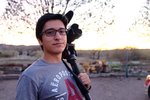Wind: 29.9 mph, W
Welcome to our new web site!
To give our readers a chance to experience all that our new website has to offer, we have made all content freely avaiable, through October 1, 2018.
During this time, print and digital subscribers will not need to log in to view our stories or e-editions.











Ilana Lapid’s film students were halfway through the spring semester when the worldwide pandemic hit, and the New Mexico State University campus transitioned to online instruction.
Students in Lapid’s Border Documentary Film Production and the Social Impact of Film classes were left wondering what to do next. Three students had filmed enough material to complete their border-themed documentaries. The rest were forced to abandon those projects and come up with something new.
“Across the board, my students rose to the occasion and impressed me with their creativity, flexibility and resourcefulness, in spite of the many challenges they were dealing with,” said Lapid, associate professor of NMSU’s Creative Media Institute (CMI). “Virtually from one day to the next, their lives had radically changed. Many were forced to move back home with their families. They had to adjust to the reality of online classes. Some had lost their jobs and sources of income. They had to pivot mid-semester and begin a new film project, which they would have half the time to complete, without access to CMI’s equipment,” Lapid said.
Out of the chaos emerged six short documentaries that speak to the heart of family, community and human resilience in the time of COVID-19. Lapid was so impressed with the students’ films that she approached KRWG-TV to air them on Las Cruces’ public television earlier this month.
“They made incredible films,” Lapid said. “They threw themselves into their projects and their final films are by turn thoughtful, moving, funny and poignant. Across the board, all the films are socially relevant.”
Christina Zuni focused her film, “Protecting Native Nations,” on the impact of COVID-19 on Native American communities.
“Although I am a hands-on filmmaker, I was able to put my producing skills to the test and put out a call sheet for submissions via Facebook, Instagram and Twitter,” Zuni said. “Within a two-month timeframe, I had gotten submissions from over 15 people from three different tribes in New Mexico and South Dakota.”
Gabe Balderas’ documentary, “How to Keep Dad Safe,” hits close to home and is very personal.
“My dad is currently on peritoneal dialysis. He has been for a year now, as we await the go-ahead for a transplant,” Balderas said. “Mostly people don’t know that or the fact that I plan to donate one of my kidneys to him. That was a matter I always wanted to keep private. However, I have no idea how much time my loved ones have left in this world, or even me for that matter, so I decided to make this film. I owe that man my life, and the least I can do is make a film about him.”
Araceli Hernandez and Dominic Vincent’s short documentary idea began with immigration, took a few turns and ended with “Success!” – sort of.
“The first half of the semester was focused on capturing stories from the Mexican-American border,” Vincent said. “While working on that project, I learned a lot about the lives of immigrants and how unique every single story truly is. The doc was about two women who spent 14 months helping Central American immigrants begin their lives in the U.S., and it was life-changing.”
The team had to set the immigration documentary aside temporarily and begin another project. When that too failed, their third try was something completely different.
“After our attempts to find good news stories within our community failed, we decided we would make a documentary about making a documentary,” said Hernandez. “We kind of just went with it and tried to make light of our failed attempts.”
“‘Success!’ is really a documentary about failure and how to learn from it, and then taking something that didn't turn out so well and making it better,” Vincent said.
Hernandez agreed. “We would just like for people to laugh with us and be able to laugh at their own setbacks, too. I guess we just felt that the world needed a little more optimism considering everything that’s going on. We just wanted to create something lighthearted and fun.”
Michael Stewart’s documentary, “Cosplay Lockdown,” centers on the art of cosplay ¬– the practice of dressing up as a character from a movie, book or video game.
“My film is about wanting to cosplay during the COVID-19 pandemic lockdown,” Stewart said. “I express how, for some people, cosplaying is a way to express oneself and bring out their creative side. I hope people can see that there are cosplayers in New Mexico, and not just cosplayers, but black cosplayers, as well. I want to show that there are cosplayers still creating their visions even during the lockdowns.”
Lily Valerio’s film, “The Girl in A302,” turns the camera on her roommate as the NMSU senior negotiates her final days toward graduation amid the pandemic.
“What I wanted to explore in my film was the way that people were adapting their daily life routines to the quarantine, and I knew that Yamilex, my roommate, would be a good subject for it,” Valerio said. “She is very opinionated and has no problem expressing her thoughts and feelings. Besides, she has an amazing personality that I knew would transmit through the camera.”
Joshua Trinidad’s film, “Alone Together,” is about his experience practicing social distancing with his family.
“I wanted my film to evoke a sense of positivity in a world full of pessimism and negativity, to inspire others to look around their own lives and find fulfillment,” Trinidad said. “My family was always a constant driving force to achieve the best. This documentary is a tribute to them. With every project I get involved in, I always put my heart into it with the idea that I can make a change in the world. Even if the world doesn't change, you keep going and keep creating. That is something Ilana taught us very well – to be resilient.”
As the global pandemic continues to evolve, Lapid said CMI remains committed to training students to become skilled visual storytellers, working across media platforms. CMI faculty will continue to keep NMSU students safe while providing them with opportunities to make films. She added the department will create new protocols in keeping with government health organizations and university policies – perhaps smaller crews filming in open spaces where students can maintain social distancing.
“I’m very proud of everyone on the CMI faculty who worked extremely hard to innovate their teaching methodologies while still holding true to learning objectives,” said CMI Department Head Amy Lanasa. “The work from Ilana’s classes is a great representation of how our faculty and students rose to the challenge. But we’re also built for this kind of thing. Filmmaking is, by nature, an exercise in creative problem solving. Ilana helped her students navigate this new terrain with such empathy and enthusiasm, which resulted in this beautiful, often vulnerable work, created in a non-traditional manner, during a very weird time in the world. I’m so grateful to see that such things can still exist,” Lanasa said.
View the films at https://m.youtube.com/channel/UC-J3QI7C8GZczc4EjbH4YSw.
Contact Minera Baumann at 575-646-7566 and mbauma46@nmsu.edu. Contact NMSU Creative Media Institute Department Head Amy Lanasa at amyla@nmsu.edu. Contact NMSU Creative Media Institute Associate Professor Ilana Lapid at 575-646-5652 and ilapid@nmsu.edu.
Other items that may interest you
